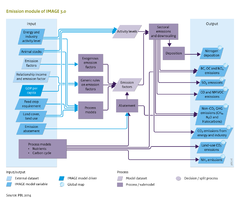Emissions/Description: Difference between revisions
Jump to navigation
Jump to search
No edit summary |
No edit summary |
||
| Line 26: | Line 26: | ||
==Future emission factors are based on different rules:== | ==Future emission factors are based on different rules:== | ||
* Emission factors can follow an exogenous scenario such as the Current Legislation Scenario (CLE), a scenario developed by [[Cofala et al., 2002]]. The CLE scenario aims to describe the current policies of different regions in the period 2000-2030. | * Emission factors can follow an exogenous scenario such as the Current Legislation Scenario (CLE), a scenario developed by [[Cofala et al., 2002]]. The CLE scenario aims to describe the current policies of different regions in the period 2000-2030. | ||
* An alternative rule is that emissions follow the empirically observed trend of the Environmental Kuznets Curve ([[EKC]]) ([[Stern, 2003]]; [[Smith et al., 2005]]; [[Van Ruijven et al., 2008]]; [[Carson, 2010]]; [[Smith et al., 2011]]). The EKC (as interpreted here) suggests that, starting from low-income levels, per capita emissions will originally increase with increasing per-capita income but at some point will peak and subsequently decline. The latter is driven by increasingly tight environmental policies, but also by shifts within sectors towards industries with lower emissions and improved technology. While such shifts do not lead to lower absolute emissions, the average emissions per unit of energy use declines (for more discussion on the EKC, see below). | * An alternative rule is that emissions follow the empirically observed trend of the Environmental Kuznets Curve ([[HasAcronym::EKC]]) ([[Stern, 2003]]; [[Smith et al., 2005]]; [[Van Ruijven et al., 2008]]; [[Carson, 2010]]; [[Smith et al., 2011]]). The EKC (as interpreted here) suggests that, starting from low-income levels, per capita emissions will originally increase with increasing per-capita income but at some point will peak and subsequently decline. The latter is driven by increasingly tight environmental policies, but also by shifts within sectors towards industries with lower emissions and improved technology. While such shifts do not lead to lower absolute emissions, the average emissions per unit of energy use declines (for more discussion on the EKC, see below). | ||
* Combinations of a prescribed period, followed by further rules based on income levels. | * Combinations of a prescribed period, followed by further rules based on income levels. | ||
Revision as of 11:41, 15 January 2014
Parts of Emissions/Description
| Component is implemented in: |
Components:and
|
| Projects/Applications |
| Models/Databases |
| Key publications |
| References |
|
